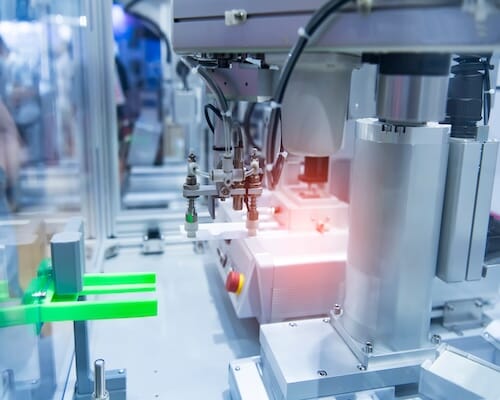
Single Stage vs 2 Stage Air Compressor: Five Critical Differences
June 26, 2024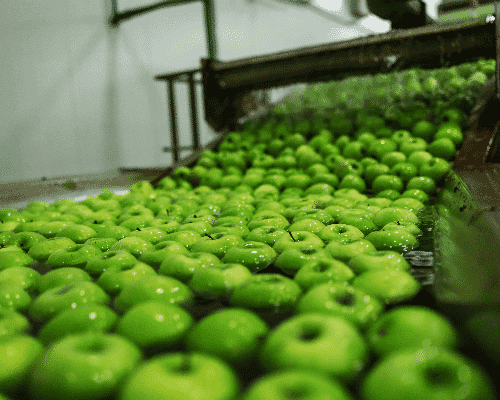
Keeping Vacuum Costs Down
July 10, 2024Five Key Applications of Rotary Screw Vacuum Pumps in the Food and Beverage Industry
Kaishan USA | July 03, 2024 | Uncategorized
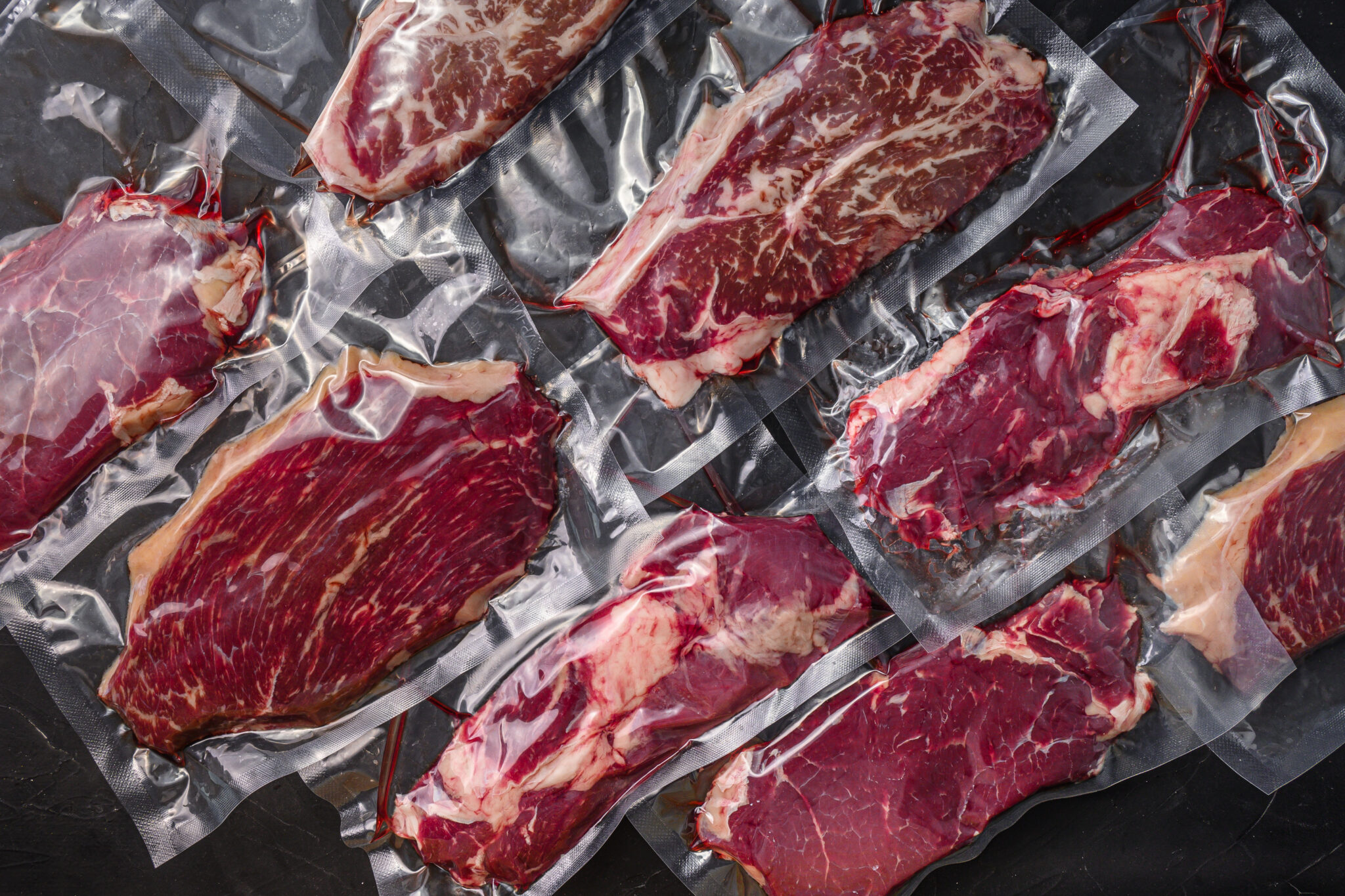
Vacuum technology removes air from food packaging to prevent spoilage and contamination.
The food and beverage industry uses vacuum technology in many applications, including handling and packaging.
We differentiate the five pivotal food and beverage applications listed below by the level of vacuum required.
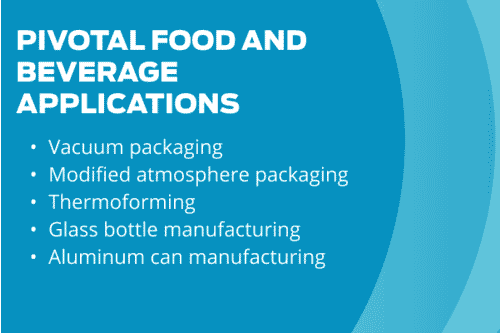

Vacuum packaging helps preserve freshness, extend shelf life, prevent contamination and ensure food retains its natural flavor and texture.
1. Vacuum Packaging and Preserving
Attractive, hygienic vacuum packaging helps preserve freshness, extend shelf life, prevent contamination and ensure food retains its natural flavor and texture. In addition, the elimination of oxygen cuts the activity of bacteria and helps prevent spoilage.
Vacuum packaging is the application we typically associate with food processing—deli lunch meats, fish, cheese and other perishable items. These processes generally require a vacuum level of 29-29.9” HgV.
Coffee is also modified into bricks using a vacuum process.
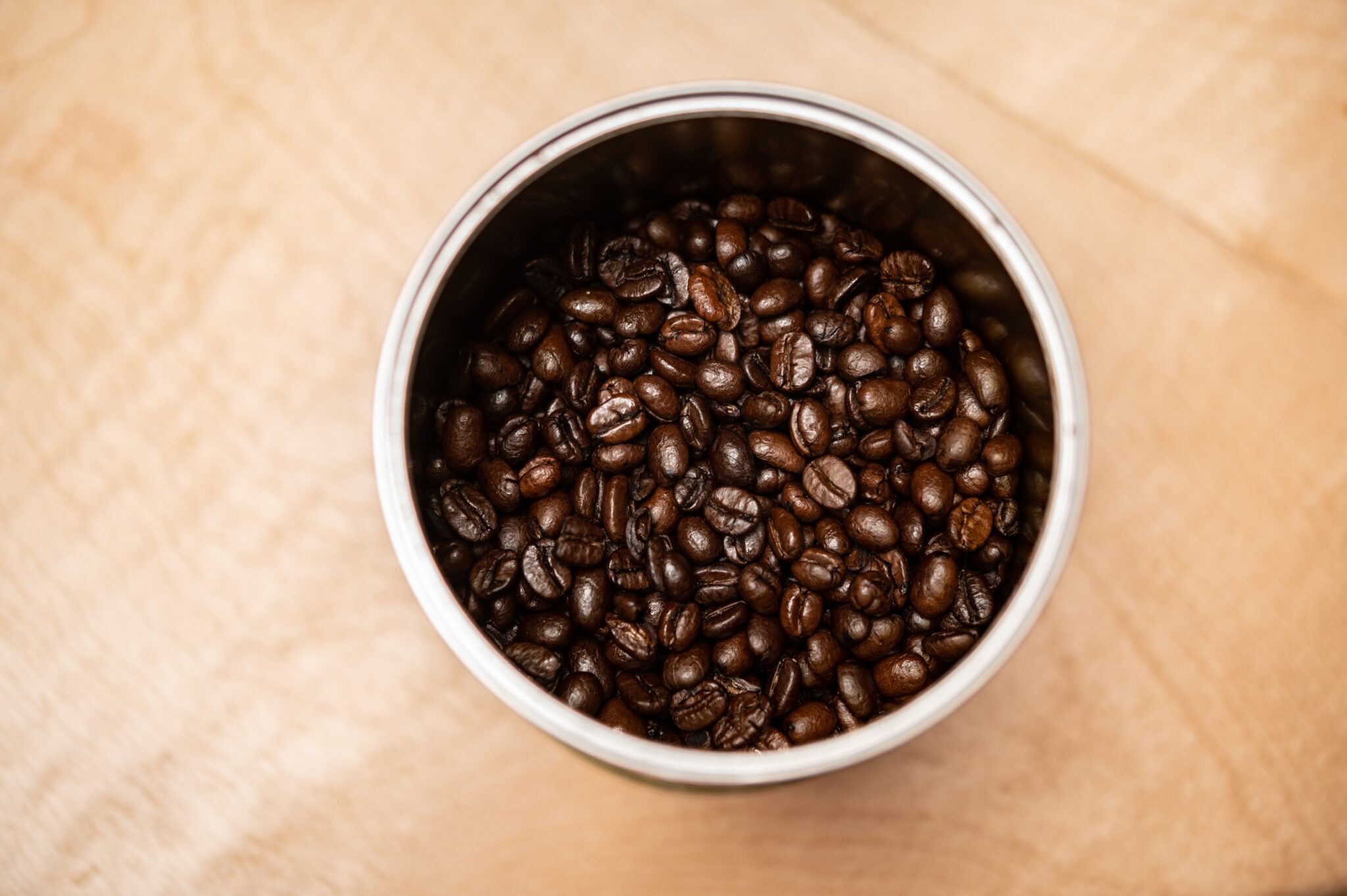
In the modified atmosphere packaging and gas flushing process, a vacuum sucks air out of the coffee can, and an inert gas like nitrogen is injected into it.
2. Modified Atmosphere Packaging/Gas Flushing
Modified atmosphere packaging, or MAP, is for foods such as bags of shredded cheese and cans of nuts that would not do well in a traditional vacuum package because of the force applied. Shredded cheese, for example, would coagulate.
So the MAP process uses a vacuum to suck the air out of the package at the same time it injects an inert gas like nitrogen into it.
That’s the gas-flushing part of the MAP process that modifies the atmosphere inside a can of products, such as nuts or coffee.
Anything with a desiccant package, like beef jerky, is also generally packaged using MAP.

Vacuum technology supports the creation of thermoformed trays that package many different food products.
3. Thermoforming/Shaping
Thermoforming creates plastic trays that hold products such as meat, candy and so on. These processes generally need a vacuum level of 24-27” HgV.
Low tooling costs, fast product development and prototyping, and extensive design options make thermoforming an attractive packaging alternative in a variety of industries, beyond food and beverage.
Containers made with thermoformed plastics are sturdy and user-friendly for consumers. In addition, they offer custom design capabilities, texture and color variety, and sustainable bioplastic options.
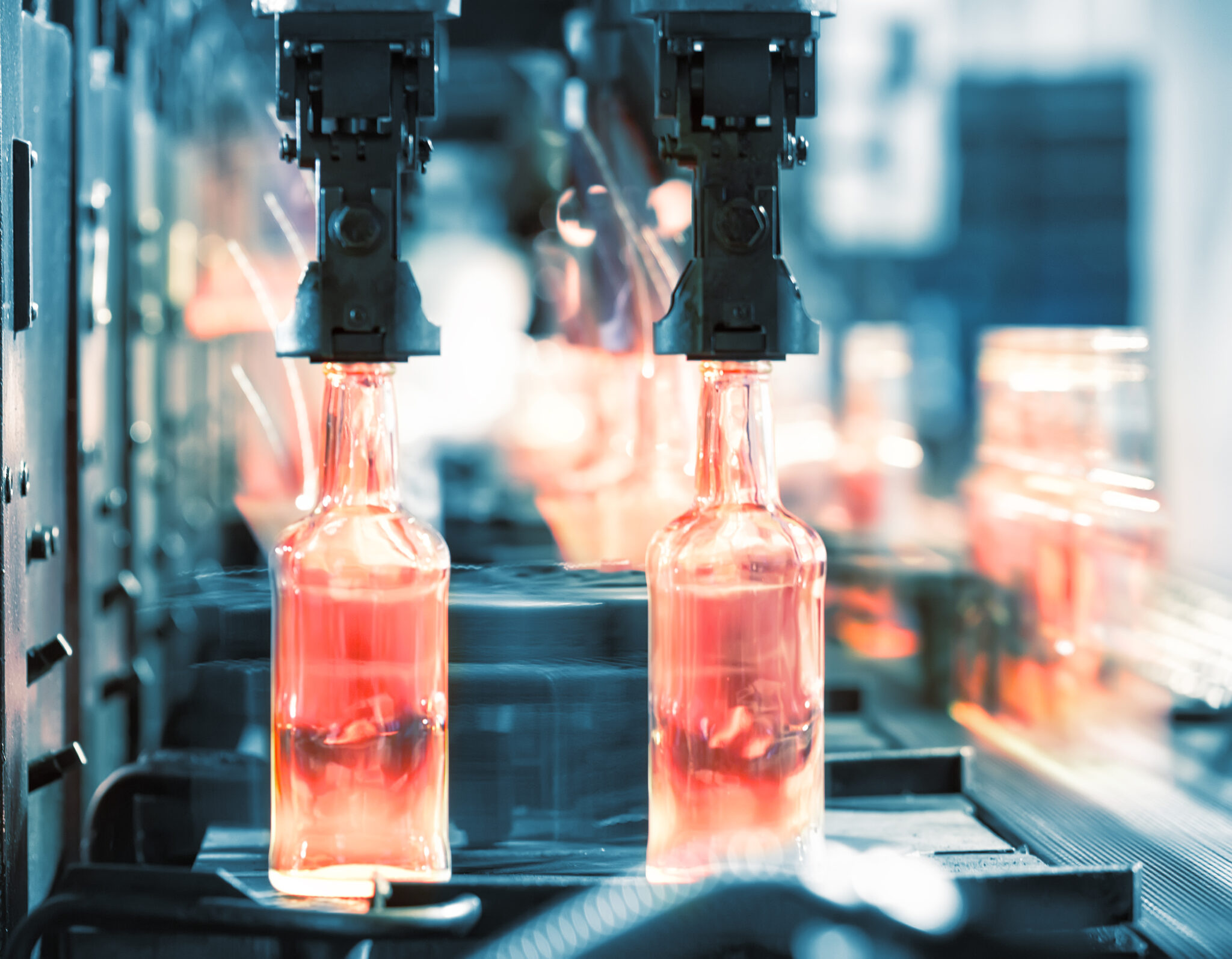
Millions of bottles are manufactured every day at a vacuum level of 25” HgV.
4. Glass Bottle Manufacturing
Glass bottles and containers are also manufactured at a vacuum level of 25” HgV. The glassmaker takes a glob of molten glass, holding it by the neck as they blow it into shape with compressed air. The mold they’re blowing it into employs a vacuum to pull the glass in place, creating the intricate details on ball jars or mason jars, for example.
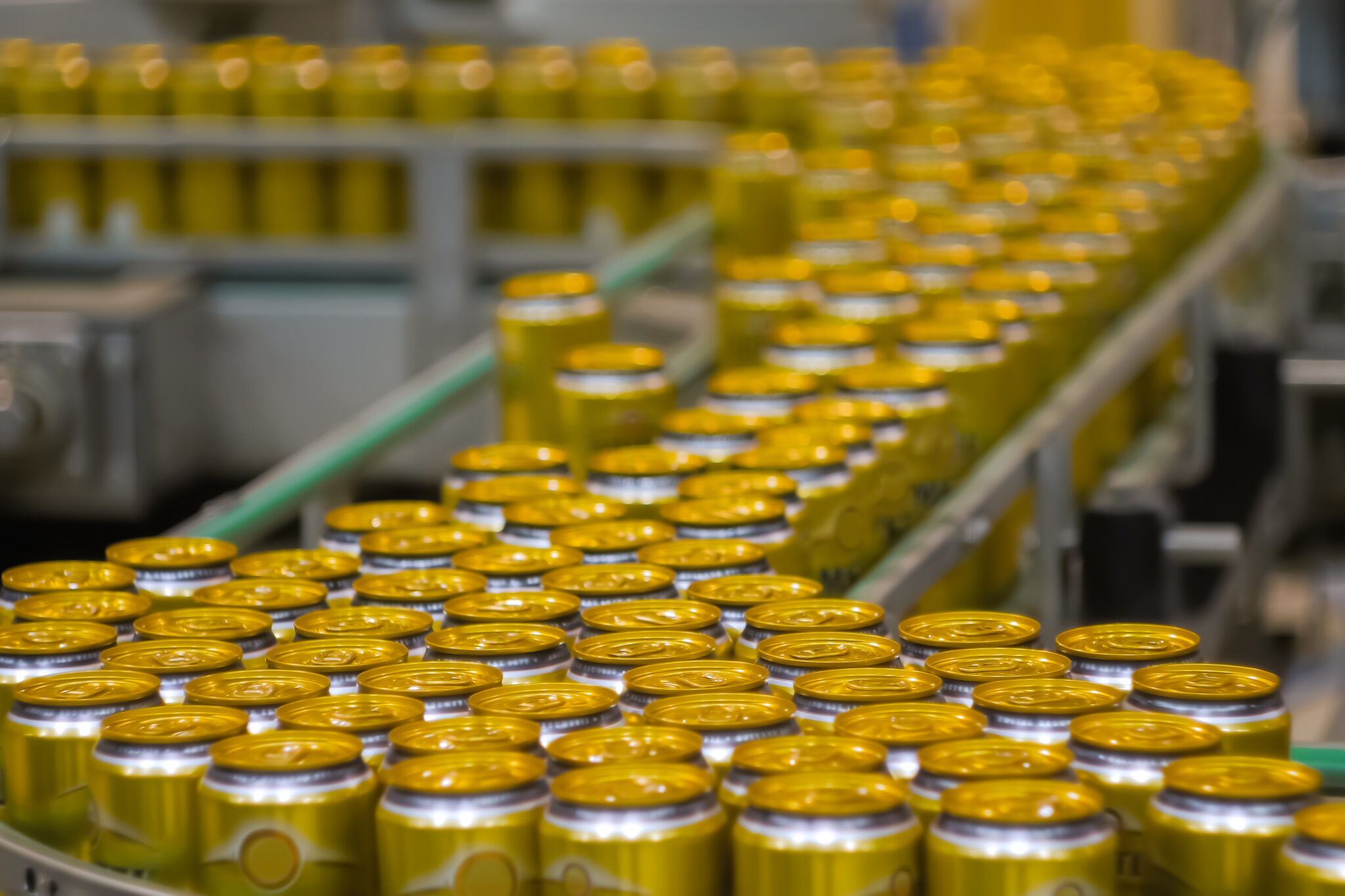
Vacuums hold beer cans in place on a conveyor as they move from process to process.
5. Aluminum Can Manufacturing
Not to be outdone, some facilities make millions of aluminum cans every day for breweries. These applications need vacuum levels of 20-24” HgV.
Years ago, breweries packaged their product in steel cans, holding them in place with a magnetic conveyor belt. Since aluminum is not magnetic, breweries have turned to vacuums to hold cans in place as they move from process to process.
In a similar application, vacuums at a level of 18-22” HgV hold, lift and move delicate foods to prevent damage. Think of taking loaves of bread out of a pan.
Types of Industrial Vacuum Pumps
There are many different types of vacuum pumps used in the food and beverage industry, including side-channel or regenerative blowers and lubricated and dry rotary vane, dry-claw, and oil-lubricated or dry rotary screw vacuum pumps.
Some plants use several small, point-of-use rotary vane vacuum pumps, each attached to a different application. However, many are finding that they are not efficient or cost-effective.
First, rotary vane pumps require frequent maintenance and repair, usually every 500-2,000 hours, with repairs generally costing 60% of the purchase price. Multiply that by the number of applications (and pumps), and you have a significant cost. A service nightmare. And a lot of downtime.
On the other hand, a rotary screw vacuum pump will last 16,000 to 20,000 hours before any significant maintenance is required. Rotary screw vacuum pumps equipped with the proper technology deliver tremendous advantages when compared to the smaller rotary vane vacuum pumps many plants use today. Including the ability to handle partial loads.
As a result, plants that eliminate their point-of-use rotary vane pumps and centralize their vacuum systems with a rotary screw vacuum pump can save on electricity bills and avoid frequent, avoidable maintenance costs—ending high energy costs and the constant repair and replacement of multiple rotary vane pumps.
Instead, you’ll substitute an industrial-strength vacuum capability that matches the rough vacuum needs of all your equipment.
Rotary Screw Vacuum Pumps: Benefits Summary
We recommend using an oil-flooded rotary screw vacuum pump for vacuum levels measuring between 18 and 29.9 inches of mercury, with the most effective ranges coming between 22 and 29.9” HgV.
The benefits of a rotary screw vacuum pump include:
-
- Low energy consumption. Rotary screw vacuum pumps optimize the energy required to perform at various vacuum levels, thereby increasing overall efficiency.
- Low maintenance costs. As mentioned above, a rotary screw vacuum requires less maintenance than many commonly used pumps. The lower maintenance costs cut their total cost of ownership significantly.
- Long life. Rotary screw vacuum pumps will last years or even decades with minimal maintenance, like oil changes and oil monitoring. By contrast, the life expectancy of vane vacuum pumps is much shorter.
- Automatic alerts. The pumps automatically alert you when performance falls below a specified threshold.
- Controls. Sophisticated microprocessor controls are constantly monitoring and fine-tuning machine operations to meet your needs and are often capable of notifying the owner via email if there is an issue.
- Low noise. Many rotary screw vacuum pumps are quiet enough to hold a conversation nearby.
Kaishan’s KRSV: VSD, Variable-Discharge Port and Oil Pump
Kaishan’s KRSV perfectly matches the needs of the food and beverage industry, reducing maintenance and electrical costs.
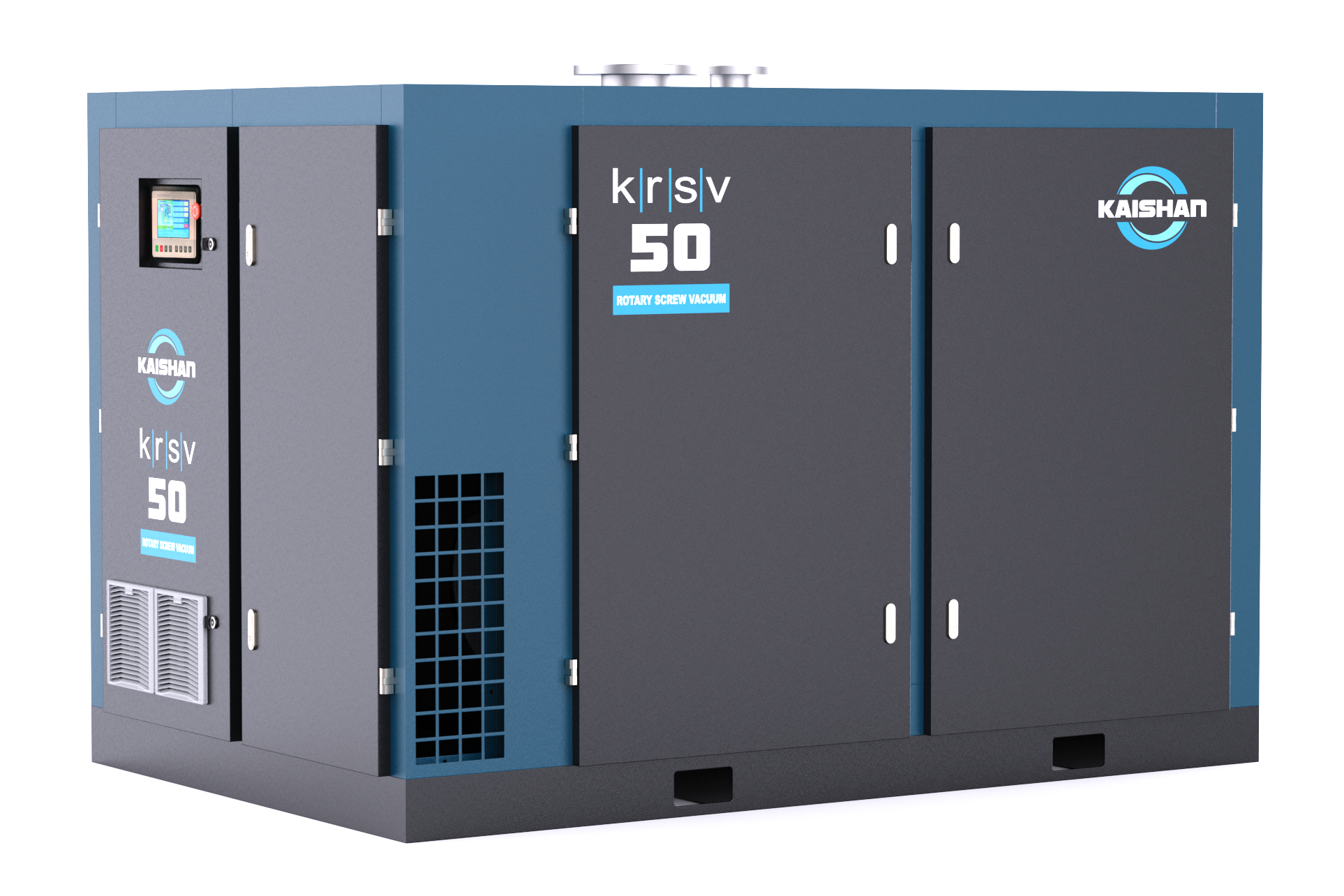
Rotary screw vacuum pumps are known for outstanding reliability and longevity. And our KRSV rotary screw vacuum pump combines a variable-speed drive with a variable-discharge port, making it highly efficient over a wide range of pressures and operating flows.
KRSV is the only industrial vacuum pump on the market that combines all of the following advanced features:
Variable-Speed Drive
By adjusting the flow and power consumption to achieve the desired vacuum levels, VSD-enabled industrial vacuum pumps like the KRSV are 30-50% more efficient than a fixed-speed rotary screw vacuum pump or rotary vane pump and 40-60% more efficient than a liquid ring pump.
Variable-Discharge Port
A variable-discharge port increases KRSV’s volumetric efficiency and performance. It balances the compression ratio and maintains it in an ideal range, keeping the pump from over-compressing the air and doing work that is not required at that moment. As the pressure changes, the port immediately adjusts to ensure maximum efficiency, always maintaining the perfect size. Thus, the compression ratio stays at the optimum level at all pressures.
An industrial vacuum pump like the KRSV equipped with variable-discharge port and a variable-speed drive will achieve maximum flow and energy savings at any level within its operational range.
A variable-discharge port responds quickly when you start it up, enabling you to achieve a high level of flow for the horsepower consumed. It combines with the variable-speed drive to give you great flow and energy savings at all vacuum levels.
KRSV’s VSD-variable discharge port combination also adds a level of protection. If the system goes quickly from full vacuum and full demand to ambient pressure levels, a VSD alone will not slow down quickly enough. As a result, the unit would over-amp, causing nuisance alarms or harming the motor. The combination of the VSD and variable discharge port keeps this scenario from happening.
Oil Pump
Most competitive vacuum pumps rely on differential pressure to provide lubrication. However, if a process requires frequent stops and starts, going quickly from full vacuum and full demand to ambient pressure levels, there is no differential pressure, and hence, no oil flow. So, the pump has to start slowly to build up that pressure.
KRSV’s oil pump begins moving oil on startup, allowing you to ramp up to maximum RPM quickly without the risk that the unit will not have adequate lubrication. As a result, you can begin working almost immediately, saving you time between pieces.
Combining the oil pump—allowing us to ramp up faster—and the variable discharge port—permitting more flow at shallow volumes—enables us to boost productivity significantly. In our tests, we could draw a 500-gallon tank down to vacuum 28% faster than a VSD-only pump could.
Greatest CFM Per Horsepower
KRSV’s design delivers the greatest efficiency in CFM per horsepower—providing the most flow for the horsepower consumed at every vacuum level and thus keeping electricity consumption stable.
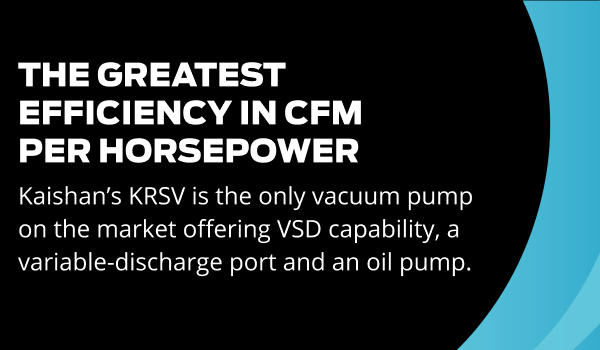
It is the only vacuum pump on the market offering VSD capability, a variable-discharge port and an oil pump. As a result, Kaishan’s KRSV gives you an unequaled operational range (with turndown capabilities up to 90% of the maximum), helping you avoid the need for blow-off. It can scale down to 10% of full load, matching the vacuum output to the plant’s CFM demand and saving significantly on energy costs. We had one recent plant where the savings on energy costs alone delivered a payback in nine months!
Local Help
We strongly recommend that you work with a vacuum professional to select and size a vacuum pump to meet your plant’s needs. Kaishan USA works with a nationwide network of independent distributors, who can provide on-site help and consultation as needed. These factory-trained experts can service your vacuum system without a problem. And they have staff members skilled in implementing and maintaining advanced technology.
Key Takeaways
-
- The food and beverage industry uses vacuum technology in a wide range of applications.
- Five pivotal food and beverage applications include vacuum packaging, modified atmosphere packaging, thermoforming, aluminum can manufacturing and glass bottle making.
- While many plants use small, point-of-use rotary vane vacuum pumps for each end-use application, they are finding that these pumps are neither efficient nor cost-effective.
- Rotary screw vacuum pumps deliver tremendous advantages when compared to the smaller rotary vane vacuum pumps.
- Kaishan’s KRSV is the only vacuum pump on the market offering VSD capability, a variable-discharge port and an oil pump as standard features.
- The KRSV delivers the most flow for the horsepower consumed at every vacuum level.
Let Us Help
Adding state-of-the-art vacuum equipment to your food and beverage plant could have an enormous impact on your operation. If you need help determining the right vacuum pump for your needs, get in touch with the experts at Kaishan. Contact us today.

